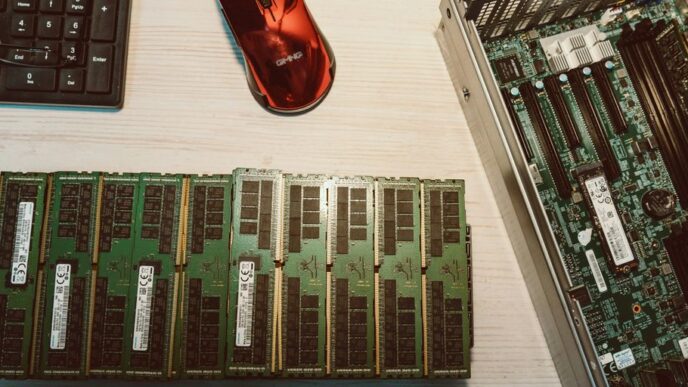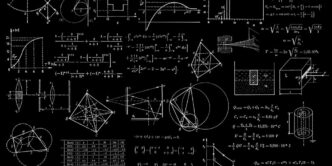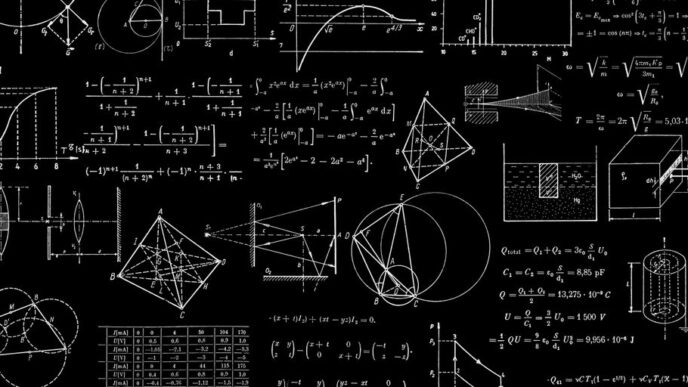So, you’re curious about quantum mechanics? It’s a wild ride, honestly. It’s the science that looks at the super tiny stuff, like atoms and the bits inside them. Things get pretty weird down there, not like the everyday world we’re used to. We’ve put together this guide, a quantum mechanics pdf, to help make sense of it all. Think of it as your ticket to understanding some of the most mind-bending ideas out there, without needing a PhD.
Key Takeaways
- Quantum mechanics deals with the behavior of matter and energy at the atomic and subatomic levels.
- Key ideas include wave-particle duality, where tiny things can act like both waves and particles.
- The Uncertainty Principle states you can’t know both the exact position and speed of a particle at the same time.
- Quantum entanglement is a strange connection where particles can influence each other no matter the distance.
- Quantum mechanics is the basis for many modern technologies like lasers, LEDs, and the future of quantum computing.
Understanding Quantum Mechanics: A Comprehensive Quantum Mechanics PDF Guide
So, you’ve decided to take a peek into the world of quantum mechanics. Good for you! It’s a subject that can seem pretty out there at first, and honestly, even the pros admit it’s not the easiest thing to wrap your head around. But that’s exactly why we’ve put together this guide – to break it all down without making your brain melt. We’ll cover the basics, like what exactly quantum physics is and why it’s so different from the stuff we see every day. Think of it as getting to know the tiny building blocks of everything, and how they play by a completely different set of rules.
What is Quantum Physics?
Quantum physics is basically the study of how the universe works at its smallest scales – think atoms and the bits inside them, like electrons and photons. Unlike the physics we experience in our daily lives, where things have a definite place and move in predictable ways, the quantum world is a bit fuzzier. Particles can act like waves, and their properties aren’t always fixed until you actually measure them. It’s a bit like trying to describe a cat that’s both asleep and awake until you open the box. This field helps us understand phenomena that classical physics just can’t explain.
The Principles of Quantum Mechanics
At its heart, quantum mechanics is built on a few core ideas that really shake up our common sense. One of the big ones is that energy and matter come in discrete packets, or ‘quanta’. You can’t just have any amount of energy; it has to be a multiple of a basic unit. Another key principle is that the act of observing or measuring a quantum system can actually change its state. It’s not just about passively looking; your observation is part of the experiment. We’ll explore how these principles lead to some pretty wild but experimentally verified outcomes. Understanding these foundational ideas is key to appreciating the rest of the quantum world, and you can start by looking at how we select a preferred basis for Hilbert spaces.
Applications of Quantum Mechanics
Even though quantum mechanics deals with the super small, its effects are all around us. Technologies we use every single day rely on its principles. Think about lasers, which are used in everything from barcode scanners to eye surgery. Or the semiconductors in your phone and computer – they wouldn’t work without quantum mechanics. Even medical imaging techniques like MRIs owe a lot to quantum principles. It’s pretty amazing how these tiny, often counter-intuitive rules govern so much of our modern world and continue to drive innovation in fields like computing and materials science.
Key Concepts in Quantum Mechanics Explained
Wave-Particle Duality
So, what’s the deal with wave-particle duality? Basically, it’s this wild idea that tiny things, like electrons and photons, can act like both waves and particles. It’s not like they’re switching back and forth, but rather they possess both characteristics simultaneously. Think of it like this: sometimes you see the particle-like behavior, and other times you see the wave-like behavior, depending on how you’re looking at it or what experiment you’re doing. It’s a bit like how a coin can be heads or tails, but it’s still a coin. This concept really threw a wrench into classical physics, where things were either waves or particles, not both. It’s a core idea that helps explain a lot of the weirdness in the quantum world, and it’s pretty mind-bending when you first wrap your head around it. It’s a concept that’s been around for a while, and it’s still a big part of understanding how the universe works at its smallest scales. We can see this duality in action in experiments like the double-slit experiment, where individual particles seem to interfere with themselves like waves. It’s a strange but true aspect of quantum mechanics.
The Uncertainty Principle
Next up is the Uncertainty Principle, famously associated with Werner Heisenberg. This principle states that there’s a limit to how precisely we can know certain pairs of properties of a particle at the same time. The most common example is position and momentum. The more accurately you know where a particle is, the less accurately you can know how fast it’s moving, and vice versa. It’s not about our measuring tools being bad; it’s a fundamental property of nature itself. Imagine trying to pinpoint the exact location of a tiny, fast-moving speck of dust while also knowing its exact speed and direction – it’s just not possible at the quantum level. This principle has big implications for how we understand and predict the behavior of quantum systems. It means we can’t always know everything about a particle with perfect certainty, which is a big departure from classical physics. It’s like there’s an inherent fuzziness built into the universe. This uncertainty is a direct consequence of the wave-like nature of particles; a spread-out wave doesn’t have a single, precise position.
Quantum Entanglement
Finally, let’s talk about quantum entanglement. This is perhaps one of the most bizarre and fascinating aspects of quantum mechanics, so much so that Einstein famously called it "spooky action at a distance." Entanglement happens when two or more particles become linked in such a way that they share the same fate, no matter how far apart they are. If you measure a property of one entangled particle, you instantly know the corresponding property of the other particle, even if it’s light-years away. It’s like having two coins that are magically linked: if one lands on heads, the other instantly lands on tails, every single time, without any communication between them. This interconnectedness is a really strange feature of the quantum world and has potential applications in areas like quantum computing and secure communication. Scientists are exploring how to harness this spooky connection for new technologies, and it’s a hot topic in physics research today. The way these particles are linked is through their shared quantum state, and this connection persists until one of the particles is measured or the entanglement is broken. This phenomenon is a key ingredient for many proposed quantum technologies, including quantum computing.
Exploring Quantum Phenomena
Quantum mechanics, as we’ve touched upon, is pretty wild. It’s not like the physics we see in our everyday lives with billiard balls and falling apples. Things get really strange when you look at the tiny stuff, like atoms and the particles inside them. It’s like a whole different set of rules apply down there. This section is all about some of the experiments and ideas that really show just how different the quantum world is. We’ll look at how things we usually think of as particles can act like waves, and vice versa. It’s a mind-bender, for sure, but it’s also how a lot of modern technology works, from lasers to the very electronics in your phone. It’s fascinating to see how these seemingly abstract concepts have real-world impacts. It’s a bit like trying to understand how a spaceship works before you can even imagine going to space, a bit like the early days of space tourism ambitions.
The Photoelectric Effect
This is one of those experiments that really got physicists scratching their heads back in the day. Basically, when light hits certain metals, it can knock electrons right off. Sounds simple enough, but the weird part is that it doesn’t matter how bright the light is; it’s the color, or frequency, of the light that counts. If the light’s frequency is too low, no electrons come off, no matter how long you shine the light. But if the frequency is high enough, even a dim light will kick electrons out. Einstein explained this by suggesting that light itself comes in little packets of energy, called photons. The energy of each photon depends on the light’s frequency. It’s like trying to knock a ball off a shelf – you need to hit it with enough force (frequency), not just keep nudging it gently (brightness).
Black Body Radiation
Imagine heating up a piece of metal. It starts to glow, first red, then orange, then yellow, and eventually white or even blue if you get it hot enough. Black body radiation is about the light emitted by an idealized object that absorbs all radiation falling on it and emits radiation based only on its temperature. When scientists tried to explain the spectrum of light coming from these objects using classical physics, their theories predicted that the object should emit an infinite amount of energy at very short wavelengths – a problem they called the
The Atom and Quantum Physics

So, how did we get from the old idea of atoms to the weird quantum picture we have today? It’s a pretty interesting story, really. For a long time, people thought atoms were just tiny, solid balls. Then, things started to get complicated.
Bohr Model of the Atom
Niels Bohr came along and gave us the Bohr model. He suggested that electrons orbit the nucleus like planets around the sun, but only in specific, allowed paths. Think of it like a ladder; electrons can only be on certain rungs, not in between. This model was a big step because it explained why atoms give off specific colors of light, like a fingerprint for each element. It worked really well for hydrogen, the simplest atom, and even for atoms with just one electron. However, it couldn’t quite explain what happens in atoms with more electrons, or why some light lines split up when you put a magnet nearby. It was a good start, but not the whole story.
Quantum Model of the Atom
This is where things get really mind-bending. The quantum model says electrons aren’t just little balls whizzing around in neat circles. Instead, they’re more like clouds of probability. We can’t pinpoint exactly where an electron is and how fast it’s going at the same time – that’s the uncertainty principle at work. It’s more about the chances of finding an electron in a certain area around the nucleus. This idea that properties like energy come in specific packets, or ‘quanta’, is what gives quantum mechanics its name. It’s a bit like saying you can only buy eggs in dozens, not just one or two. This model helps us understand the complex behavior of all sorts of atoms and how they interact with light, which is key to understanding how light interacts with atoms.
The Franck-Hertz Experiment
This experiment was a real game-changer. It showed that electrons jumping between these specific energy levels in atoms don’t just do it randomly. They have to absorb or give off a precise amount of energy to make the jump. Imagine trying to move a ball between shelves; it needs a specific push to get to the next shelf, not just any old shove. The Franck-Hertz experiment confirmed that these energy levels are indeed quantized, just as Bohr had proposed. It provided solid experimental proof for the idea that energy within atoms isn’t continuous but comes in discrete packets, a core concept in quantum physics.
Advanced Topics in Quantum Mechanics
This section gets into some of the more complex ideas in quantum mechanics. It’s where things start to get really interesting, and maybe a little mind-bending. We’ll look at the math and the concepts that really define quantum theory.
The Schrödinger Equation
The Schrödinger equation is a big deal in quantum mechanics. It’s basically the rulebook that tells you how quantum systems change over time. Think of it like Newton’s laws for the tiny world. It uses something called a wave function, which is like a probability map for where a particle might be. Solving this equation gives us a peek into the quantum future of a system. It’s not always easy to solve, especially for complicated situations, but it’s the core of how we predict what happens in quantum experiments. You can find some detailed notes on this and other advanced topics here.
Particle Creation and Annihilation
This is where things get really wild. In quantum field theory, particles aren’t just static things; they can pop into existence and disappear. This happens all the time in high-energy physics. For example, when two particles collide with enough energy, they can create new particles. It’s like magic, but it’s all governed by quantum rules. This process is called particle creation. The opposite, annihilation, happens when a particle and its antiparticle meet – they disappear and release energy, often as photons. It’s a fundamental part of how the universe works at its most basic level.
The Compton Effect
The Compton effect is a really neat demonstration of light acting like a particle. When X-rays hit electrons, they scatter, and the wavelength of the X-rays changes. This change in wavelength depends on the angle the X-rays scatter. Arthur Compton figured out that this happens because the X-ray photon collides with an electron, like two billiard balls hitting each other. The photon loses some energy and momentum to the electron, and that’s what causes the wavelength shift. It was a key piece of evidence showing that light isn’t just a wave; it also has particle-like properties, which is a core idea in quantum mechanics.
Quantum Technologies and the Future
It’s pretty wild to think about how much quantum mechanics is already woven into our lives, even if we don’t always realize it. We’re talking about stuff that’s changing how we communicate, compute, and even how we light up our homes. The real game-changer, though, is probably quantum computing. It’s not like your laptop or phone will suddenly become a quantum machine, but these powerful tools are being developed for really specific, complex problems. Think about simulating chemical reactions for new medicines or materials, or breaking codes that are currently super secure. It’s a bit like having a super-specialized tool that can do things no regular tool can even dream of.
Lasers and LEDs
Remember when lasers were just sci-fi stuff? Now they’re everywhere, from scanning groceries to performing surgery. LEDs, too, have totally changed lighting. They use way less energy and last ages longer than old-fashioned bulbs. Plus, there’s this neat idea called LiFi, which uses LED lights to create wireless computer networks. Pretty cool, right?
Quantum Computing Explained
So, what’s the big deal with quantum computers? Well, instead of using bits that are either a 0 or a 1, quantum computers use ‘qubits.’ These qubits can be a 0, a 1, or, thanks to quantum mechanics, both at the same time – that’s called superposition. This ability lets quantum computers tackle problems that would take even the best supercomputers millions of years. They’re not for everyday tasks like email or browsing, but for things like drug discovery, financial modeling, and cracking tough encryption. Companies and countries are pouring billions into this because the potential is huge. It’s a bit like trying to build a whole new kind of engine, and it’s still early days, but the progress is really something. You can even access some of these machines remotely to try out simple programs, which is a neat way to see what they can do. The race is on to achieve ‘quantum superiority,’ where a quantum machine definitively beats a classical one on a specific task, though there’s still debate about when that’s truly been achieved. It’s a complex field, with many different approaches being explored to build these machines, and a lot of work going into the software side too.
Superconductivity and Superfluidity
Superconductivity is when certain materials can conduct electricity with zero resistance, usually at very low temperatures. Superfluidity is similar but for fluids – they can flow without any friction. These aren’t just lab curiosities; they have potential applications in things like super-efficient power grids and advanced medical imaging. Getting these effects to work reliably and at more accessible temperatures is a major research goal, and it’s another area where quantum mechanics plays a starring role in how we understand and manipulate matter.
Wrapping Up Our Quantum Journey
So, we’ve covered a lot of ground, from the really small stuff to how it all connects to things we use every day. It’s a wild ride, for sure, and maybe not everything clicked perfectly the first time. That’s okay, though. Quantum mechanics is famously tricky, and even the pros scratch their heads sometimes. The main thing is that this stuff works. It helps us build lasers, make our phones smarter, and even look inside our bodies. Don’t worry if you don’t feel like an expert yet; nobody expects you to be. Just keep that curiosity going. There’s always more to learn in this fascinating field.
Frequently Asked Questions
What exactly is quantum physics?
Quantum physics is the study of the tiniest things in the universe, like atoms and the particles inside them. It’s a bit like a special set of rules that govern how these super small things behave, which is often very different from how bigger things we see every day act.
How can something be both a wave and a particle?
Think of it this way: sometimes tiny things act like little balls (particles), and other times they act like waves, like ripples on water. This strange dual nature is a core idea in quantum mechanics.
What is the Uncertainty Principle?
This principle says you can’t know everything about a tiny particle at once. For example, the more precisely you know where it is, the less precisely you can know how fast it’s moving, and vice versa. It’s a fundamental limit on what we can measure.
What is quantum entanglement?
Quantum entanglement is a spooky connection between two or more particles. When particles are entangled, they are linked in such a way that they instantly affect each other, no matter how far apart they are. Measuring something about one particle immediately tells you something about the other.
Is quantum physics used in everyday technology?
Yes! Many technologies we use daily rely on quantum physics. Things like lasers in barcode scanners and DVD players, the transistors in your phone and computer, and even medical imaging like MRIs all use quantum principles.
Do I need to be a genius to understand quantum physics?
While it might seem complicated, the basic ideas of quantum physics can be understood with curiosity. You don’t need to be a super-genius! Many people find it fascinating to learn how the universe works at its smallest levels.














